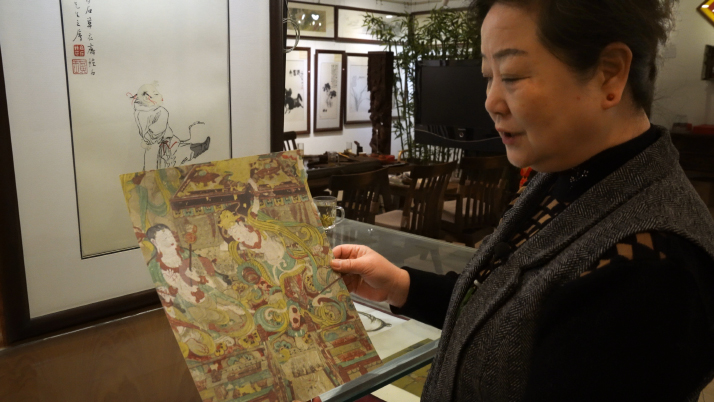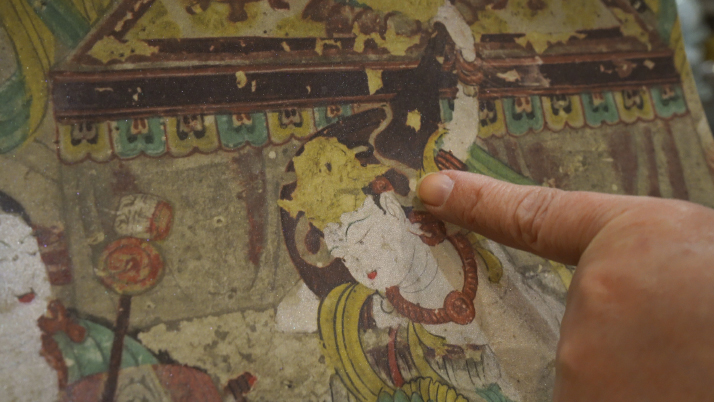An Inheritor of Photocollography Spends Decades Reproducing the Mogao Murals

Photocollographer Li Dongfang introduces a reproduction of a Mogao mural (left) in Beijing on November 9, 2022 (ZHANG WEI)
When she finally arrived at her destination after days and nights of taxing travel, she was welcomed by a starlit sky that was unlike anything she'd ever seen. "The sky was like a big pot lid, and the stars covered me like a quilt," Li recalled.
But her initial excitement was soon replaced by a sense of anxiousness in the face of an unknown future. She had come to Dunhuang to visit the Mogao Grottoes, a UNESCO World Heritage Site located about 25 km from the city at the edge of the Gobi Desert.
Comprising numerous caves featuring countless sculptures, murals and manuscripts, the grottoes, or Mogao Caves (also known as the Caves of the Thousand Buddhas and the Dunhuang Caves), were constructed over a period of 1,000 years, from the 4th to the 14th century and to this day are the greatest treasure trove of Buddhist art found in a single locality anywhere in the world.
One year earlier, Li had read an article about Japanese painter and educator Ikuo Hirayama's visit to these caves, who suggested certain features of Nihonga, or traditional Japanese painting, could help reproduce prints of the illustrious Mogao murals.
The article inspired Li, who decided to write to Duan Wenjie, then director of the Dunhuang Academy, saying she could do something similar by reproducing the murals using photocollography, also known as collotype, a reproductive printmaking technique that is based on photography.
Six months after she'd mailed the letter, Duan finally wrote back, saying: "Welcome to Dunhuang, you have my support." And so, on July 30, 1984, Li met the Mogao murals, a meeting that changed her life for good. "The ancient murals are exquisite. Their beauty will stun anyone who sees them," she told Beijing Review.
"But unfortunately, time does leave its stamp; they fade and peel. So [back then] I just figured: If I can reproduce them through photocollography, it will be an asset for future generations."
How it all began…
In the early 1970s, responding to then Premier Zhou Enlai's proposal to revitalize collotype in China, Li, who was working at the National Cultural Heritage Administration, started learning the printing method at the Palace Museum, or the Forbidden City, in 1974. "It's almost impossible to fully grasp such a difficult technique," Li, who had practiced sketching for three years before trying her hand at photocollography, thought at the time.
Invented by French chemist Alphonse Poitevin in 1856, the technique was especially popular in the early 20th century for its effectiveness in reproducing the subtle delicacy of drawings and photographs. A photographic negative is projected onto a printing plate coated with light-sensitive gelatin that hardens and becomes receptive to the application of ink. Paper is laid on top and the image is printed with a press.
The technique entered China in the late 19th century. Including four steps—photographing, retouching, plate making and printing—it requires an accurate analysis of the original colors and expert retouching skills to correct any distortions in the negatives. The best reproduction requires many modifications, delicate manual work and endless patience.
Arriving in Dunhuang, Li fully believed she could make a difference. But life surrounded by desert wasn't easy. "I couldn't acclimatize to life in Dunhuang when I first got there. The weather was dry. We newcomers often got nosebleeds. Also, homesickness drove me to tears," she said.
But all these thoughts would vanish every time she saw the murals and got immersed in exploring their culture and beauty, Li explained.
Her first reproduction was that of a mural showing Vimalakirti, the only layman who holds a prominent position within Buddhism, in a face-to-face debate with the Bodhisattva Manjusri. This was her "entrance exam" given to her by Duan, who had tried copying the mural with his paintbrush many times before but was never satisfied with the result. So he wanted to evaluate the feasibility of collotype.
Li poured a lot of effort into the undertaking, polishing it again and again over a period of one month. In her duplication, Vimalakirti's eyes are sparkling, capturing his radiance. "Photocollography can perfectly reproduce the original work, and even print the fine details and capture its appeal."

In the summer of 1984, a train from Beijing, with then 27-year-old Li Dongfang on board, traveled over 2,000 km to Dunhuang, a city in Gansu Province in northwest China. Before that, the farthest from home Li had ever been was the city of Tianjin—then a two-hour drive from China's capital. (ZHANG WEI)
Recording history
Jumping headfirst into her newfound passion, Li then quit her job in Beijing, relocated to Dunhuang and embarked on a long journey of reproducing the Mogao murals. When she returned to Beijing in 2008, she had copied murals of nine caves.
Some art dealers did offer to buy Li's work. But Li refused despite her need for financial support to reproduce more works. "I cannot use cultural heritage to make a profit," she explained.
In 2014, Li returned to Dunhuang to celebrate the 70th anniversary of the establishment of Dunhuang Academy. She found the murals had further faded. "The change made me feel my years in the grottoes had been meaningful and without any regret. I had recorded history," she said.
That same year, Li first staged an exhibition of her reproductions themed Flowing Dunhuang, which has since traveled the world. "This way, I can introduce both the Mogao murals and collotype to a global audience."
Li has also used photocollography to copy other cultural relics. For example, she duplicated the Three Rarities of Calligraphy in 2015. These three masterpieces by the hand of calligrapher Wang Xizhi of the Eastern Jin Dynasty (317-420) are the earliest authentic works of Chinese calligraphy.
Over the past four decades, despite all the technological advances that have taken place, this photocollographer has never given up on this old technique, nor has she ever sacrificed quality for quantity.
Due to the complex manual work and printing process, the number of people engaging in this technique has been dwindling, now a dozen at best, she said. "Such good technology must not disappear within the hands of my generation."
And so it came to be that in 2020, she set up a workshop at her alma mater, the Beijing Institute of Graphic Communication, to promote the printing technology. And the collotype major at the Beijing Industry and Trade Technician College, also initiated by Li, enrolled 10 students in 2022. "Little sparks can light great fires. Only the growth of these inheritors can inject new energy into the development of collotype," Li said.